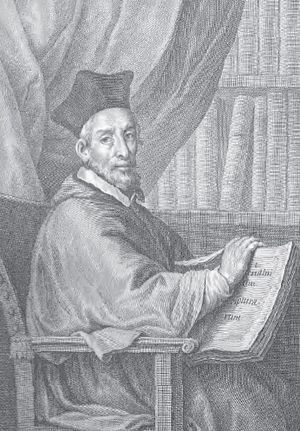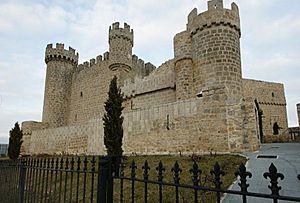Paul of Burgos facts for kids
Paul of Burgos (born around 1351 in Burgos – died August 29, 1435) was a Spanish Jew who became a Christian. He rose to become an archbishop (a high-ranking church leader) and a lord chancellor (a top government official). He was also known as Pablo de Santa María. His original name was Solomon ha-Levi.
Contents
Early Life and Learning
Paul of Burgos, originally named Solomon ha-Levi, was a very rich and important Jewish leader in the city of Burgos, Spain. He was a smart scholar who studied Jewish religious texts like the Talmud. He also served as a rabbi for the Jewish community. His father, Isaac ha-Levi, moved to Burgos from Aragon in the mid-1300s. Solomon ha-Levi also worked as a tax collector.
Why He Changed His Faith
Solomon ha-Levi became a Christian on July 21, 1391, in Burgos. He took the name Paul de Santa María. Some historians believe he converted after a terrible time in 1391 when many Jews were attacked. However, Paul himself said he was convinced by the writings of a famous Christian thinker named Thomas Aquinas.
Official church records say he converted a year earlier, but some studies suggest Paul might have changed these records himself. He might have wanted to show that his conversion was not because of the attacks.
When he converted, his brothers, Pedro Suárez and Alvar García, and his sister, María Nuñez, also became Christian. His four sons and one daughter, who were between three and twelve years old, were also baptized. His wife, Joanna Benvenisti, chose to remain Jewish and died in 1420. She was later buried in a church built by her husband. In 1406, his daughter Beatrice and youngest son Todros returned to Judaism, as a law allowed Jews to do so.
Paul's Important Career
Paul spent several years studying at the University of Paris, where he earned a degree in theology. He also visited London for a short time.
He became an archdeacon (a church official) in Treviño. In 1402 or 1405, he became the Bishop of Cartagena, and in 1415, he became the Archbishop of Burgos. His second son, Alfonso, later became Archbishop of Burgos after him.
Paul was very intelligent and a great speaker. This helped him gain the trust of King Henry III of Castile. In 1406, the King made him the keeper of the royal seal, a very important job. In 1416, King Henry named him Lord Chancellor, an even higher position.
After the King died, Archbishop Paul was part of the group that ruled Castile for the young King John II of Castile. He was also the tutor for the future king.
Paul de Santa María died on August 30, 1435. He was buried in the main chapel of the Friary of S. Pablo in Burgos, which no longer exists today. The site is now home to the Museum of Human Evolution. Many members of his family were also buried there. In 1865, what is believed to be his remains were moved to the cathedral of Burgos. They were placed in the chapel of the Visitation, next to the tomb of his son, Bishop Alfonso de Cartagena.
His Views on Judaism
Even after becoming Christian, Paul kept in touch with some Jewish leaders. However, he became a strong opponent of Judaism. He worked hard to convince other Jews to convert to Christianity, and he often succeeded.
As the Lord Chancellor, he helped create a law in 1412 that was very strict for Jews. This law aimed to keep Jews and Christians separate, make it hard for Jews to do business, and make them feel ashamed. It forced Jews to live in small, crowded areas called ghettos or to become Christian.
Paul also wrote a book called Dialogus Pauli et Sauli Contra Judæos, sive Scrutinium Scripturarum (which means "Dialogue of Paul and Saul Against the Jews, or Examination of the Scriptures"). This book was written shortly before he died and was used by other writers who were against Jews. He also wrote Additiones, which were notes added to a Bible commentary, and a Historia Universal (Universal History) in Spanish poetry.
Paul's Published Works
Archbishop Paul's main published writings include:
- Dialogus Pauli et Sauli contra Judæos, sive Scrutinium scripturarum (published in 1475 and later).
- Additiones to the Postilla (commentary) by Nicholas of Lyra (published from 1481 onwards). These notes were originally written in the margins of a book he sent to his son Alfonso.
- De nomine divino quæstiones duodecim (published in 1707). These are parts of his Additiones about the name of God.
See also
 In Spanish: Pablo de Santa María para niños
In Spanish: Pablo de Santa María para niños
- Alfonso de Cartagena
- Álvar García de Santa María
- Gonzalo de Santa María
- Teresa de Cartagena
- Francisco de Vitoria
- Isabel Osorio



